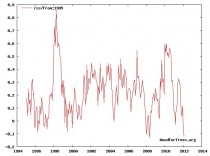Update: in TWTW newsletter from SEPP, an excellent weekly newsletter, they note this story but say if you remove the two El Ninos the lack of warming is more like a decade. I would add, remove the 0.5C cooling 1991 to 1995, the lack of warming is going on even longer than 17 years.
By Steve Goddard
In 2003, Ben Santer of Lawrence Livermore Labs wrote:
LIVERMORE, Calif. - In order to separate human-caused global warming from the “noise” of purely natural climate fluctuations, temperature records must be at least 17 years long, according to climate scientists.
To address criticism of the reliability of thermometer records of surface warming, Lawrence Livermore National Laboratory scientists analyzed satellite measurements of the temperature of the lower troposphere (the region of the atmosphere from the surface to roughly five miles above) and saw a clear signal of human-induced warming of the planet.
Separating signal and noise in climate warming
Well here is the 17 year plot of global temperatures from the IPCC’s offical source, the Hadley Center.
Temperatures have been dropping since 2005, and are the coldest now in the last seventeen years. Game over for alarmists, based on their own rules.
----------------
The latest research belies the idea that storms are getting more extreme
Dr. Harold Brooks of the National Severe Storms Laboratory in a seminar at Penn State University addressed his ongoing research that deals with the connection between severe weather and climate change. He made the following points:
1. The large variability from one severe weather season to another, combined with ever improving and easier ways of reporting severe weather, make it difficult to link severe weather and climate change.
2. Significant severe weather (tornadoes and hail storms) depend more on wind shear (change in direction of strong winds with height) rather than a combination of heat and high humidity. Shear also determines the intensity of hail and tornadoes in the U.S. and Europe. Big tornado years have hail storms as the dominant secondary severe weather events (as opposed to just damaging winds).
3. Climate models projecting a future warmer world with C02 doubled show an increase in heat and humidity, but a decrease in shear (a decrease in equator to pole gradient).
4. These high heat/humidity & low shear environments result in little overall change in severe thunderstorms. However, there may be a slight decrease in tornadoes due to less shear and an increase in significant thunderstorm straight-line wind events due to an increase in heat and humidity.
By the way, Dr. Brooks also mentioned that the downward trend in tornado deaths since the 1920’s has leveled off over the past 30 years because of an increase in people living in mobile homes.
Indeed as we have noted this situation was driven by strong shear and large instability from a very cold upper atmosphere and a sun warmed lower air. Dewpoints were actually unusually low across the area north of the Tennessee Valley. They rose during the day in the Gulf into the Tennessee Valley, areas to the north the severe weather developed in drier air than is typical with severe activity this strong. By the way, the record for March tornadoes occurred in 1976 at the start of three incredibly cold winters.



